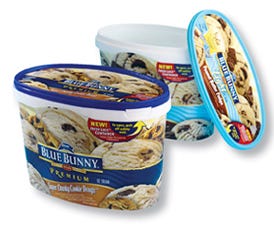Dairy favors elliptical tub
January 30, 2014

A move by Wells' Dairy, Inc., Le Mars, IA, to an elliptical, in-mold-labeled (IML), injection-molded, polypropylene container made of a specialized, freezer-grade PP resin for its Blue Bunny® ice cream brand, has helped make the brand the country's fastest-growing packaged ice cream, according to the company. “While the ice cream category as a whole has remained flat, consumers are more willing to try our product because of the innovative packaging,” says Lesley Bartholomew, manager, public relations and corporate communications for Wells' Dairy. “The ice cream is so much easier to scoop out of this package.”
Considered the largest family-owned and managed dairy processor in the U.S., Wells' Dairy offers ice cream throughout the U.S., Mexico and Puerto Rico so that aficionados can indulge and choose from nearly 500 tasty Blue Bunny flavors, frozen dairy desserts and novelties.
Earlier, Wells had been using a conventional round paperboard container with an overcap for the ice cream. But it wanted to take its brand in a new direction. Its revised 56-oz container represents the first U.S. commercial application of Basell's (www.basell.com) Pro-fax EP390S high-impact PP copolymer (opaque) resin, which can withstand drop impacts at freezer temperatures to -40 deg F without cracking or breaking. Basell says Pro-fax EP390S offers melt flows of 35 deg/min, can withstand microwaving and is dishwasher safe. The resin is designed for IML containers requiring exceptional print quality.
Injection-molded in a proprietary process by Airlite Plastics (www.airliteplastics.com), the dairy's new ice cream container demonstrates significant performance characteristics and impact-resistance at freezing temperatures, the company says. Airlite's IML process introduces a printed label into the container mold via robotics before the resin is injected into the mold. The resin then bonds the label to the container before it cools so that the label becomes an integral part of the container. The results afford superb graphic quality and a “no-label” look, according to Wells'.
An in-mold label made of PP film was chosen because of the extreme wet environment in which the ice cream is packaged and stored. The label won't separate from the container, and the product is delivered to customers in pristine condition, Bartholomew says. The label is offset-printed in five-colors by Belgium-based Verstraete (www.verstraete.be). Color-coded graphics on the label and lid rim coordinate with the different ice cream varieties: premium (royal blue); premium light (light blue); no-sugar-added/reduced fat (red); no sugar added/fat-free (green); and frozen yogurt/fat free (purple).
After filling, the lid, also made of Pro-fax EP390S, is snapped into place with a breakaway, tamper-evident tab in the container lip. Research with consumers verified their acceptance of the tub, Bartholomew adds. “Consumers said they were looking for a package that could provide fresher and safer ice cream and a cleaner, easier-to-use and more premium ice cream experience.” The new container has helped Blue Bunny hop into a fast sales surge.
More information is available: |
Basell North America, Inc., 410/996-1600.www.basell.com. |
Airlite Plastics Co., 800/228-9545.www.airliteplastics.com. |
Verstraete, N.V., 32 50 301 301. www.verstraete.be. |
You May Also Like


